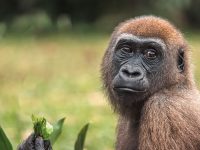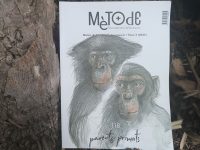Hunting roles in chimpanzees?
Cognitive aspects of group activity in this species
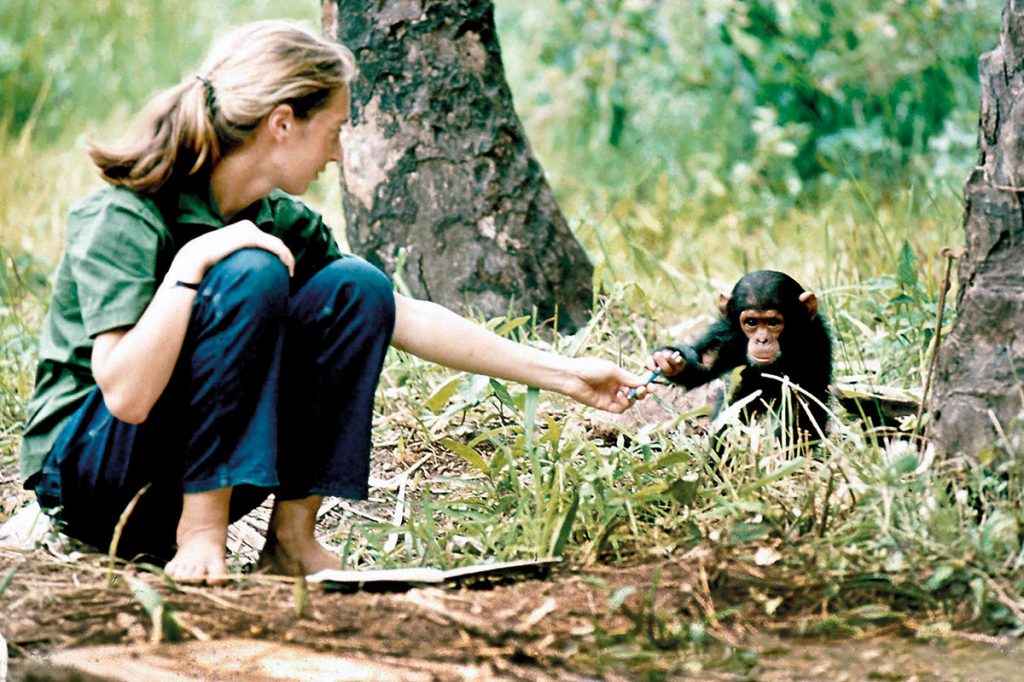
The study of chimpanzees in their natural habitat began in 1960 with the pioneering project led by palaeontologist and archaeologist Louis Leakey. As a result, Jane Goodall then spent decades among wild chimpanzees in Tanzania’s Gombe Stream National Park. The image shows Jane Goodall with the infant chimpanzee Flint. / Photo: Hugo van Lawick[/caption]Observations of chimpanzees in their natural habitat show that as well as competing, these primates often cooperate by forming coalitions, patrolling the boundaries of their territories, and hunting in groups. Perhaps because of the important role it is thought to have played in the evolution of our own species, group hunting behaviours have attracted considerable research interest. The underlying question is to what extent do chimpanzees hunt cooperatively in a human-like manner? To answer this question, we must consider not only their behaviour, but also the cognitive abilities required, given that any two similar behaviours may respond to different psychological mechanisms. Research on the cognitive aspect of cooperation has been carried out mainly through experiments with chimpanzees in captivity. The available evidence suggests that, with experience, chimpanzees are capable of coordination between individuals, but it is unclear whether they can also cooperate, i.e., act according to a common strategy.
Keywords: cooperation, hunting, cognition, animal behaviour, Pan troglodytes.
Five male chimpanzees (Pan troglodytes) walk on all fours in the jungle, resting their weight on their knuckles, as their species does. They move quickly and silently, dodging tree trunks and glancing briefly up at the treetops. Suddenly they stop and look up intently. About 30 metres above them is a group of red colobus (Piliocolobus badius), a species of cercopithecid primate. The cameras capture this and a voice-over explains: «Colobus are light and agile, so they can move in the thinnest of branches. The heavy chimpanzee hasn’t a hope alone. But this is a team and each has learnt his own specific role. […] Working together, they have a chance» (BBC Studios, 2008). Suddenly the action begins. The voice describes, now with more intensity, how the youngest and least experienced chimpanzee (the driver) climbs a tree towards the colobus and forces it to flee. Off to the side, three other chimpanzees (the blockers) run ahead, climbing trees, «ready to funnel the colobus between them». As the victims move, the blockers make the necessary adjustments to their movements in an «effort to re-form the trap». Finally, almost completely surrounded, the colobus flees in the direction of the «smartest» chimpanzee (the ambusher) who, having anticipated their route earlier than the others, is waiting for them hidden among the leaves of a tree. The ambusher emerges from his hiding place and tries to catch the colobus, which initially escapes but ends up in the hands of one of the blockers, surrounded by the alarm calls of the colobus and the excited screams of the chimpanzees in a deafening finale.
Watching animals hunt is fascinating, even more so when they hunt in groups. We often watch hunting scenes in nature documentaries and interpret the predatory behaviour of lions, wolves, and cetaceans in terms of group strategy, attributing to them a human-like understanding. But what does ethological research tell us? What do these behaviours tell us about our closest relatives, the chimpanzees, with whom we might expect to have more in common?
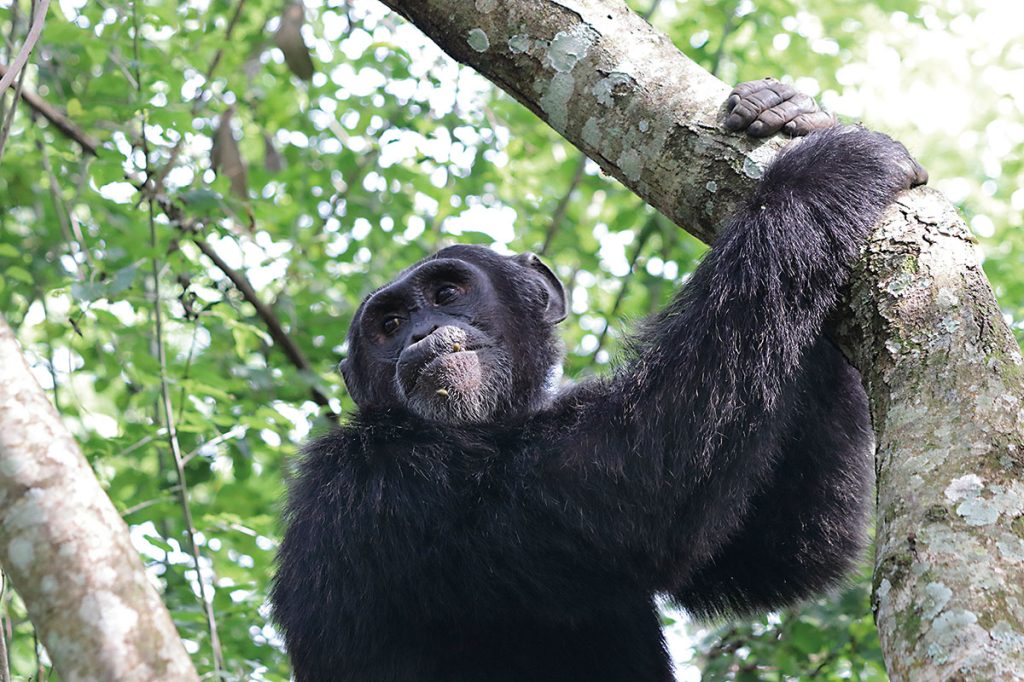
Do chimpanzees have a joint hunting strategy or what we observe is the result of the individual decisions of each member of the group? To answer this question, we must first look at whether the behaviour of each individual responds to that of the others and, if different behaviours are observed within the group, whether they follow a common pattern. / Nigel Hoult CC BT 2.0
The hunting behaviour of wild chimpanzees
The study of chimpanzees in their natural habitat began in 1960 with the pioneering project of palaeontologist and archaeologist Louis Leakey. This led Jane Goodall to spend decades among wild chimpanzees in Tanzania’s Gombe Stream National Park. Among other important discoveries – such as the fact that chimpanzees routinely make and use tools – Goodall documented cooperative behaviour such as forming coalitions and alliances, patrolling territorial boundaries, and group hunting. Five years later, the team led by Toshisada Nishida began their research just 150 km away, in the Mahale Mountains National Park, also in Tanzania (Mitani, 2009). Since then, numerous field studies have provided valuable information about the behaviour of our closest relatives, including confirming that although chimpanzees are mainly frugivores and folivores – a diet they supplement with flowers, seeds, and insects – they regularly hunt and eat meat throughout their range (Hobaiter et al., 2017).
However, the hunting behaviour of chimpanzees varies from one population to another. For example, chimpanzees in Taï National Park (Côte d’Ivoire) – studied by Christoph Boesch and his team since 1979 – hunt more frequently than those in Gombe and Mahale. They are also more specialised hunters: 95 % of their prey are colobus, especially red colobus. In addition, while chimpanzees in Gombe and Mahale prefer to hunt infant colobus and usually do so individually, in Taï they choose adult colobus and usually hunt in groups of three to five individuals (if there are fewer than five, the hunt is less likely to be successful) in a more coordinated manner, approaching the prey from different angles (Boesch & Boesch, 1989).
This diversity in behaviour has mainly been explained by the ecological characteristics of different habitats. In the forests of Tanzania, where there are generally more scattered and shorter trees – between 10 and 30 m high – adult colobus tend to fight chimpanzees, probably because they have fewer escape routes. In turn, in the rainforests of Côte d’Ivoire – where the average tree height is 30 m, but some can reach up to 60 m – colobus tend to stand still to avoid detection and begin to flee when chimpanzees approach. The lower aggressiveness of colobus, combined with the greater effort required for chimpanzees to climb trees and the high risk of them falling, would explain the preference of Taï chimpanzees for adult colobus (they are larger and provide more meat), whereas in Gombe, stealing babies from colobus mothers and diversifying prey seems to be a better strategy. On the other hand, the difficulty of hunting alone in a complex environment and the greater availability of meat (a single chimpanzee cannot eat an entire adult colobus) appears to encourage group hunting in Taï (Boesch, 1994).
But how do chimpanzees hunt cooperatively? Do they have a common strategy, or is what we observe the result of individual decisions made by each member of the group? To answer this question, we first need to look at how the hunt takes place. More specifically, whether the behaviour of each individual is sensitive to that of the others and, if different behaviours are observed within the group, and whether they follow a common pattern.
Cognitive processes in group hunting
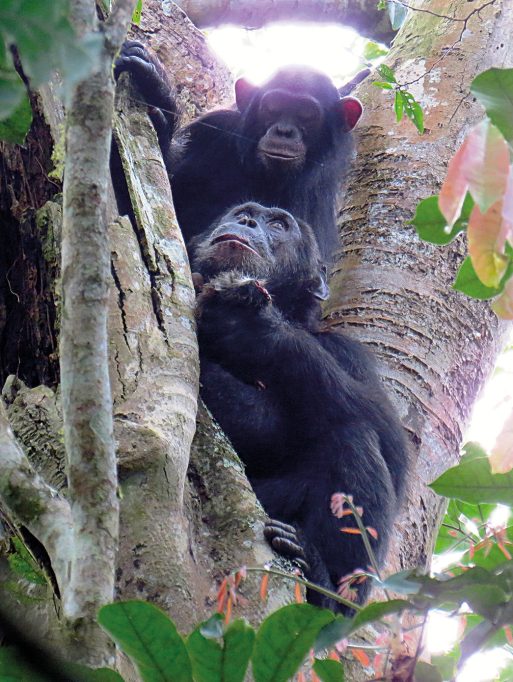
In these pictures we see a group of chimpanzees sharing the meat of a prey after the hunt, in Kalinzu Forest, Uganda. / Kathelijne Koops
Boesch and Boesch (1989) proposed a classification of possible chimpanzee hunting strategies based on their (partly cognitive) complexity. They called the most elementary strategy similarity. It corresponds to situations in which hunters concentrate similar actions on the same prey, without synchronisation or coordination between them (i.e., all running independently in the direction of the same prey). In the case of synchrony, hunters also concentrate similar actions on the same prey, but do so by synchronising (starting the hunt at the same time or adjusting their speeds to each other). In the coordination strategy, chimpanzees coordinate in time and space (approaching from different directions and strategically adjusting their positions). Finally, collaboration – the highest level of cognitive sophistication – occurs when chimpanzees perform different complementary actions directed at the same prey.
According to Boesch (2002), chimpanzees are capable of cooperation – a view that has transcended the strictly scientific realm, as evidenced by the narration of the BBC video (BBC Studios, 2008), which uses terms such as driver, blocker, chaser, and ambusher, originally proposed by Boesch. He also suggested that cooperative hunting requires chimpanzees to understand the role of other hunters and their visual perspectives. This was tantamount to saying that chimpanzees have a common intention when they hunt in a group, which means that their hunting goal involves acting together; that they represent the set of roles necessary to achieve the common goal in their minds; and that they are able to exchange roles when necessary (Tomasello et al., 2005). However, there is also reason to believe that this conclusion may have been premature.
Indeed, a criticism of Boesch and Boesch’s (1989) classification is that some chimpanzees could be individually chasing the same prey (similarity), each adapting to the movements of the prey while avoiding obstacles in the way (including other chimpanzees), and from the perspective of a human observer this could appear to be a case of collaboration, with individuals assuming the roles of driver, blocker, ambusher, and chaser according to a common intention (Tomasello et al., 2005). This is partly because of the difficulty of applying the definitions of these categories in a complex natural environment. For example, it is difficult to determine whether two chimpanzees are synchronising or spatially coordinating with each other when both are chasing the same moving prey. This is even more true when several chimpanzees are hunting at the same time!
So, what is the cognitive basis of chimpanzee group hunting: collaboration or something simpler? Answering this question requires an experimental approach to see if changing the different elements of these situations would also change their behaviour. Studying chimpanzees in captivity allows this type of manipulation, while controlling variables to a degree not possible in the natural environment.
Studying chimpanzee cooperation in captivity
With these questions in mind, I modified Boesch and Boesch’s (1989) classification and used it to review studies of cooperation with primates in captivity (Albiach-Serrano, 2015). The new classification included the following categories: independent cooperation (equivalent to Boesch and Boesch’s similarity); presence-dependent cooperation, in which chimpanzees are more likely to act in the presence of others; action-dependent cooperation, in which they are more likely to act when others are performing a particular action; coordination, in which they adjust their actions to those of others in space and time; and, to simplify a little, collaboration, in which they flexibly adjust their actions, which are complementary (based on understanding the intentions of others or even sharing intentions with them). Although studies of primates in captivity do not include hunting situations, their results help us to explain the behaviour of primates in the wild.
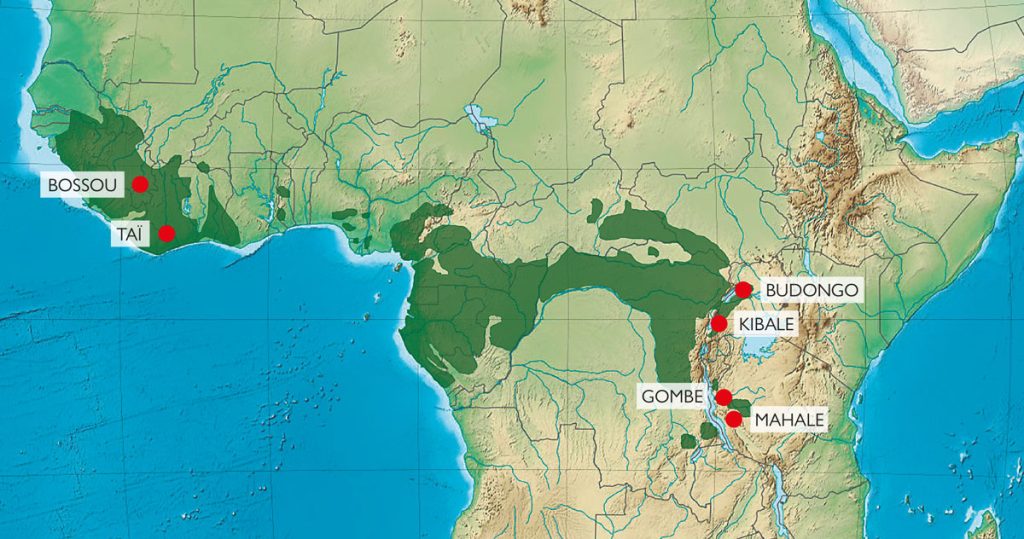
The hunting patterns of chimpanzees vary between the populations studied, with this diversity in behaviour mainly being explained by the ecological characteristics of different habitats. The map above shows the locations of the main longitudinal studies of wild chimpanzees: Bossou, Republic of Guinea; Taï National Park, Côte d’Ivoire; Budongo Central Forest Reserve and Kibale National Park, Uganda; and Gombe Stream National Park and Mahale Mountains National Park, Tanzania. / Miguel Crespo
In an experiment performed at the beginning of the last century, the psychologist Wolfgang Köhler (1925) hung a banana from the ceiling of a chimpanzee enclosure, out of reach of a group of chimpanzees. They learned to stack boxes to reach it, but they did so individually, they did not cooperate to form the stack. In fact, they would steal boxes from each other. They did move a heavy box together until it was under the banana, but Köhler interpreted the chimpanzees’ success on the basis of their aligned goals (independent cooperation). Since then, researchers around the world have devised ingenious experiments to test primates’ ability to cooperate, and systematically, chimpanzees – like the other species studied – have not cooperated spontaneously to solve these tests.
For example, chimpanzees failed to spontaneously coordinate to push a heavy rock to reach food hidden underneath it (Hirata et al., 2010) or to simultaneously pull two strings to move a heavy box full of food (Crawford, 1937). They also failed to simultaneously pull both ends of the same rope running inside a box full of food (in a «loose string apparatus»). This system was set up in such a way that if one chimpanzee pulled without waiting for the other, the rope would come off the apparatus and they would lose the opportunity to bring it closer to them (Hirata & Fuwa, 2007). None of this behaviour was spontaneous. Nevertheless, some primates were able to solve some of these problems with enough experience – in some cases with the help of training. How they did this gives us an idea of the cognitive mechanisms at work.
For example, Povinelli and O’Neil (2000) presented the heavy box problem to pairs of chimpanzees consisting of an experienced chimpanzee (trained to cooperate) and an untrained chimpanzee. The pairs that solved the task did so because the experienced individual considered the partner’s position near the apparatus (presence-based cooperation). In another experiment, an adult and a juvenile chimpanzee learned to pull the two levers of a food dispenser at the same time, each taking into account the other’s presence near the apparatus and, in the case of the adult, also considering the partner’s actions, given that he did not pull the lever until the juvenile did, representing action-based cooperation and perhaps also coordination (Chalmeau, 1994). Surprisingly, in these studies, the more experienced individual (in the first case) and the older one (in the second) showed more complex organisation.
This is consistent with what has been described in the field – Taï chimpanzees do not begin to be effective at hunting colobus until the age of 10 and continue to improve throughout their lives, only participating in ambushes after 20 years (Boesch, 2002). In Chalmeau’s study, it was striking to observe the adult leading the juvenile to the levers on more than one occasion. Similarly, Crawford (1937) observed one chimpanzee pushing the partner, who was visibly less motivated to participate, towards the table as if to encourage him to cooperate (see video Living Links, n.d.). Although these behaviours are anecdotal and could be the result of repetition – the result of operant conditioning – they certainly suggest recognition of the partner’s role, understanding their attentional state, and communicating their own matching intentions, as would be expected in the case of cooperation.
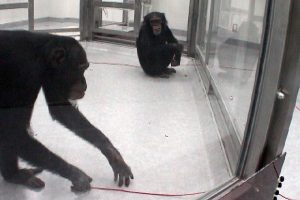
Researchers have devised ingenious experiments to test the cooperative abilities of primates in captivity. The picture shows a «loose string apparatus»: two food boxes with a rope running through them. If a chimpanzee pulls on one end without waiting for his partner to pull on the other, the rope comes off and they lose the opportunity to bring the box closer to them. / Hirata and Fuwa (2007) – Primates
Some authors have suggested that chimpanzees can indeed collaborate. Melis et al., (2006), for example, argue that chimpanzees know when they need a cooperator because, for instance, they open the door for another chimpanzee when they need them to manipulate the loose-string apparatus. They also contend that, when given the opportunity, chimpanzees choose the best partner – the one who previously cooperated most effectively. Similarly, Melis and Tomasello (2019) argued that chimpanzees understand the role of others and, if necessary, help them to perform that role by providing them with materials or information about their location. For example, in their study, one chimpanzee indicated the location of two tools by standing near the box containing them. Thanks to this, the other chimpanzee found them and passed one (the appropriate one) to his partner so that, together, they could extract food from a device. Unfortunately, the results of these and other similar studies may be, at least in part, an artefact of the experimental setting (see Albiach-Serrano, 2015, for a critical methodological review).
However, there is evidence that chimpanzees, unlike children from the age of three, do not prefer cooperation to working alone. They do not give communicative signals to indicate their intention to cooperate or stop, nor do they care about the outcomes obtained by others while cooperating. In other words, they do not commit to continuing cooperation until their partner receives the reward if they themselves have already received it, nor do they share the reward more with those who cooperated with them (Albiach-Serrano, 2015; Duguid & Melis, 2020). Therefore, it does not appear that chimpanzees share intentions as humans do, with some field primatologists offering interpretations of hunting consistent with this view (e.g., Gilby et al., 2008). However, there is evidence that members of this species might perceive others as intentional agents and also know what others see (Duguid & Melis, 2020). Thus, the possibility that chimpanzees collaborate according to their understanding of others’ intentions – anticipating their actions and acting according to the potential consequences – cannot be ruled out and therefore merits further investigation.
Deepening our understanding of cooperation
Studies in captivity have shown that, with enough experience, chimpanzees learn to solve new problems cooperatively. They do this by considering the presence and actions of other chimpanzees and by coordinating with them in space and time. These mechanisms may be sufficient to explain the hunting behaviour of wild chimpanzees, who prefer to hunt in groups in complex environments and appear to act in a coordinated manner (more so with age and experience). While field observations initially suggested that chimpanzees might also be capable of teamwork in the sense of sharing intentions, studies in captivity have not found convincing evidence of this, and some primatologists have proposed new interpretations of hunting that do not take this cognitive capacity into account. However, it remains to be seen whether chimpanzees could collaborate based on understanding each other’s intentions. If so, this would suggest that our common ancestor, who lived more than six million years ago, may also have had this ability, with both chimpanzees and humans having inherited it. Future studies will allow us to answer these questions and deepen our knowledge of the exciting and not always easy phenomenon of cooperation. Thus, cross-species comparisons will be key to understanding the evolutionary history of this trait and the selective pressures that may have led to it.
ACKNOWLEDGEMENTS
I would like to thank the authors of the photographs used in the text for their collaboration, and Joan Salazar and the two anonymous reviewers for their invaluable comments on the final version of this article.
REFERENCES
Albiach-Serrano, A. (2015). Cooperation in primates: A critical, methodological review. Interaction Studies, 16(3), 361–382. https://doi.org/10.1075/is.16.3.02alb
BBC Studios. (2008). Chimpanzees team up to attack a monkey in the wild [Video]. YouTube. https://www.youtube.com/watch?v=A1WBs74W4ik
Boesch, C. (1994). Chimpanzees-red colobus monkeys: A predator-prey system. Animal Behaviour, 47(5), 1135–1148. https://doi.org/10.1006/anbe.1994.1152
Boesch, C. (2002). Cooperative hunting roles among taï chimpanzees. Human Nature, 13(1), 27–46. https://doi.org/10.1007/s12110-002-1013-6
Boesch, C., & Boesch, H. (1989). Hunting behavior of wild chimpanzees in the Taï National Park. American Journal of Physical Anthropology, 78(4), 547–573. https://doi.org/10.1002/ajpa.1330780410
Chalmeau, R. (1994). Do chimpanzees cooperate in a learning task? Primates, 35(3), 385–392. https://doi.org/10.1007/BF02382735
Crawford, M. P. (1937). The cooperative solving of problems by young chimpanzees. Comparative Psychology Monographs, 14, 1–88.
Duguid, S., & Melis, A. P. (2020). How animals collaborate: Underlying proximate mechanisms. WIREs: Cognitive Science, 11(5), e1529. https://doi.org/10.1002/wcs.1529
Gilby, I. C., Eberly, L. E., & Wrangham, R. W. (2008). Economic profitability of social predation among wild chimpanzees: Individual variation promotes cooperation. Animal Behaviour, 75(2), 351–360. https://doi.org/10.1016/j.anbehav.2007.06.008
Hirata, S., & Fuwa, K. (2007). Chimpanzees (Pan troglodytes) learn to act with other individuals in a cooperative task. Primates, 48(1), 13–21. https://doi.org/10.1007/s10329-006-0022-1
Hirata, S., Morimura, N., & Fuwa, K. (2010). Intentional communication and comprehension of the partner’s role in experimental cooperative tasks. In E. V. Lonsdorf, S. R. Ross, & T. Matsuzawa (Eds.), The mind of the chimpanzee (pp. 251-264). University of Chicago Press. https://www.wrc.kyoto-u.ac.jp/en/publications/SatoshiHirata/Hirata_Morimura_Fuwa_2010.pdf
Hobaiter, C., Samuni, L., Mullins, C., Akankwasa, W. J., & Zuberbühler, K. (2017). Variation in hunting behaviour in neighbouring chimpanzee communities in the Budongo forest, Uganda. PLOS ONE, 12(6), e0178065. https://doi.org/10.1371/journal.pone.0178065
Köhler, W. (1925). The mentality of apes. Harcourt, Brace & Co.
Living Links. (s. d.). Chimpanzee cooperation task video clip. 1930’s Nissen and Crawford study [Video]. https://www.emory.edu/LIVING_LINKS/media/video.shtml
Melis, A. P., Hare, B., & Tomasello, M. (2006). Chimpanzees recruit the best collaborators. Science, 311(5765), 1297-1300. https://doi.org/10.1126/science.1123007
Melis, A. P., & Tomasello, M. (2019). Chimpanzees (Pan troglodytes) coordinate by communicating in a collaborative problem-solving task. Proceedings of the Royal Society B, 286(1901), 20190408. https://doi.org/10.1098/rspb.2019.0408
Mitani, J. C. (2009). Cooperation and competition in chimpanzees: Current understanding and future challenges. Evolutionary Anthropology: Issues, News, and Reviews, 18(5), 215–227. https://doi.org/10.1002/evan.20229
Povinelli, D. J., & O’Neill, D. K. (2000). Do chimpanzees use their gestures to instruct each other? In S. Baron-Cohen, H. Tager-flusberg & D. J. Cohen (Eds.), Understanding other minds: Perspectives from developmental cognitive neuroscience (pp. 459–487). Oxford University Press.
Tomasello, M., Carpenter, M., Call, J., Behne, T., & Moll, H. (2005). Understanding and sharing intentions: The origins of cultural cognition. The Behavioral and Brain Sciences, 28(5), 675–691. https://doi.org/10.1017/S0140525X05000129

